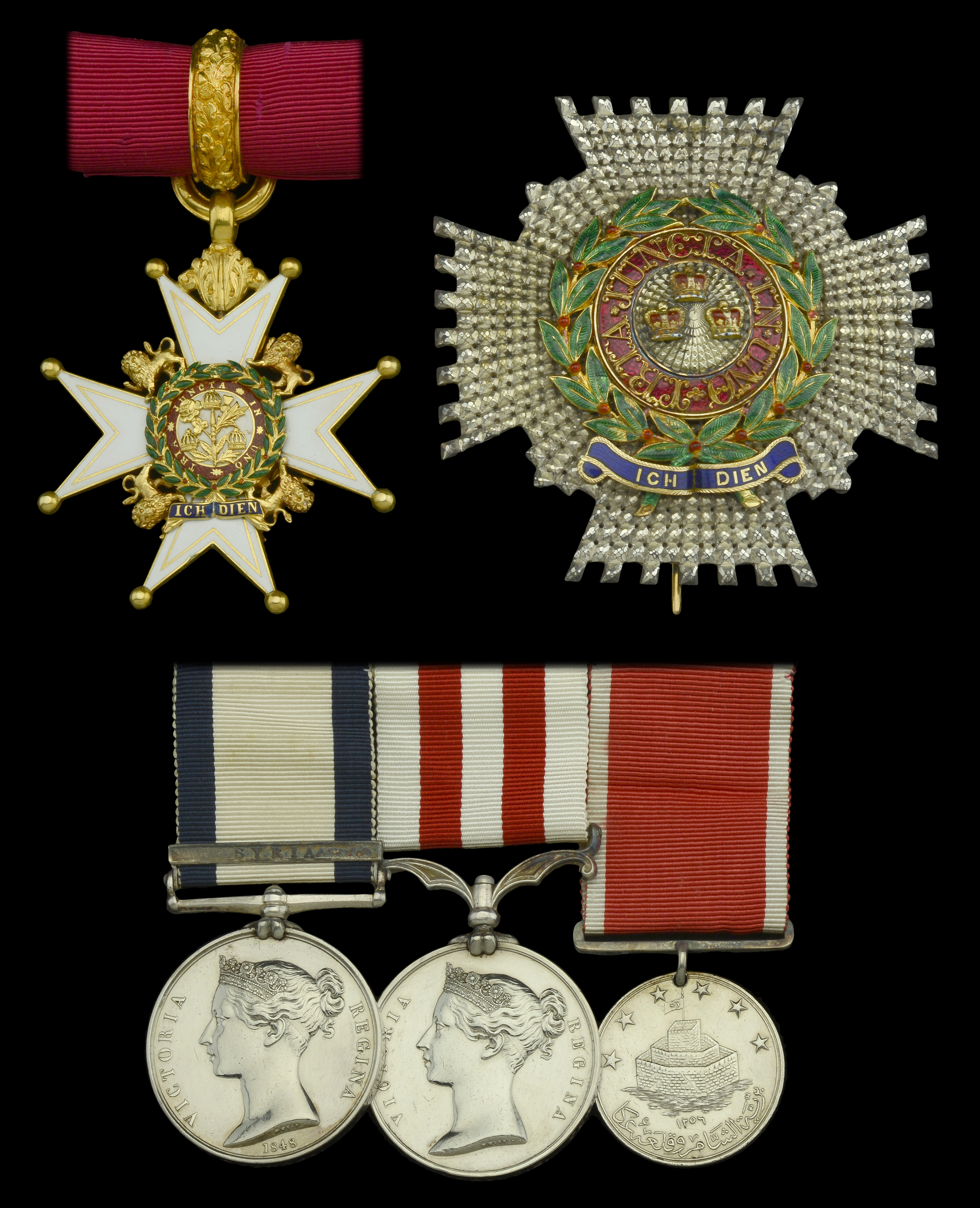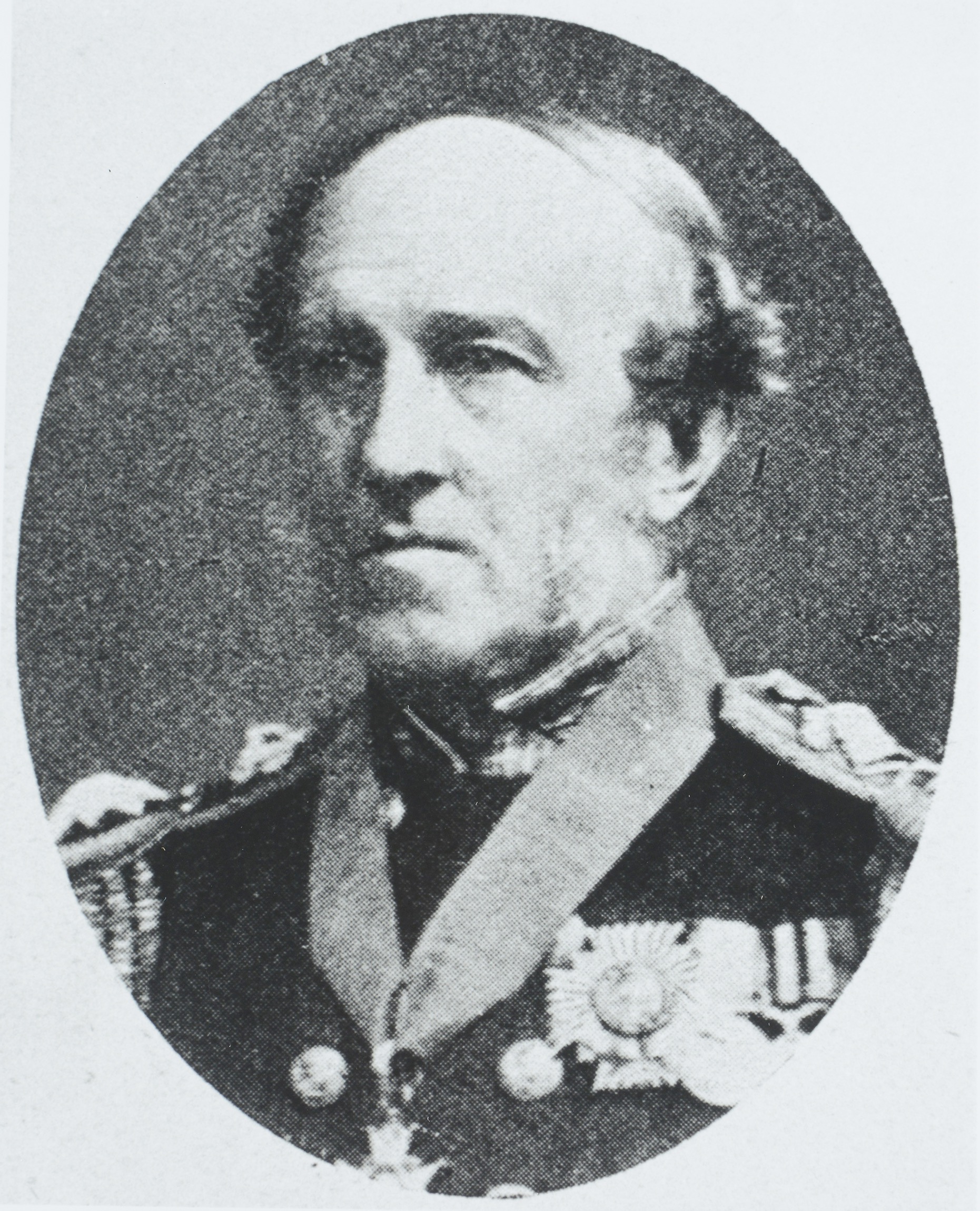The outstanding Victorian gold K.C.B. group of five awarded to Admiral Sir Edward Sotheby, Royal Navy, who was awarded the C.B. and mentioned in despatches on 13 occasions for his protracted command of Pearl’s Naval Brigade in the Indian Mutiny; he further received the Thanks of both Houses of Parliament, the Governor-General of India and the Admiralty and was appointed an Extra A.D.C. to Queen Victoria The Most Honourable Order of the Bath, K.C.B. (Military) Kinght Commander’s set of insignia, comprising neck badge, 18 carat gold and enamels, hallmarked London 1862, and breast star, silver, with gold and enamel appliqué centre; Naval General Service 1793-1840, 1 clasp, Syria (E. S. Sotheby, Lieut. R.N.); Indian Mutiny 1857-58, no clasp (Capt. Edwd. S. Sotheby, C.B. Pearl.); St Jean D’Acre 1840, silver, some minor chipping to wreaths of the Bath insignia, otherwise generally good very fine (5) £9,000-£12,000 --- Importation Duty This lot is subject to importation duty of 5% on the hammer price unless exported outside the UK --- --- K.C.B. Queen’s Birthday Honours, May 1875. Edward Southwell Sotheby was born in Clifton on 14 March 1813, second son of Admiral Thomas Sotheby (1759-1831) by his second wife, Lady Mary Anne, fourth daughter of Jospeh Deane Bourke, 3rd Earl of Mayo. After attending the Royal Naval College, Portsmouth, he first went to sea in 1828 and was promoted to Lieutenant in October 1835. A tour in the flagship Caledonia in the Mediterranean having ensued, he next joined, as First Lieutenant, the corvette Dido, in which capacity he saw action in the Syrian operations of 1840 and was advanced to Commander in October 1841. In June 1846, he was appointed to command the sloop Racehorse, in which he participated in operations in the disturbances in China and New Zealand, followed by a tour of duty in command of the Sealark in the suppression of the slave trade off the coast of Africa. As observed by W. E. F. Ward in his history of the suppression of the Atlantic slave trade, The Royal Navy and the Slavers, ‘the Navy found close inshore patrolling was a much more effective way of throttling the slave trade than making wide sweeps on the sea lanes.’ It was a challenging business, investigating estuaries blocked by sand bars and peering into countless swampy creeks and lagoons, a business which led to numerous, sometimes fatal, cases of fever and malaria. As recounted by Ward, Sotheby and the Sealark undertook just such activities and, in March-April 1852, the former’s persistence paid off when he captured a Spanish slave brigantine, but only after intense investigation of possible hideouts on the Rio Grande in Portuguese Guinea. It transpired a Spanish trader, who had an operational pseudonym, was covertly involved in slavery activity with local chiefs. Having carried out no less than 14 thorough but fruitless searches of creeks, Sotheby decided to interrogate the Spaniard and search his lodgings. Nothing appeared to be untoward, but Sotheby remained convinced of the Spaniard’s guilt and, remaining in the area, offered a 100-dollar reward for further information. His enticement did the trick, an African reporting he had knowledge of a slave brigantine and its whereabouts. And so it proved, the ‘fully equipped’ camouflaged vessel being located in a narrow side creek: unable to shift it from its anchorage, Sotheby blew it up. As it transpired, the African informant gave good value for his money, for he then took Sotheby to a hut which he said belonged to a local chief. Inside, the naval party found a hoard of muskets and assorted slave shackles, a discovery that was quickly followed by the appearance of a native on the scene. He had escaped captivity but said 19 of his tribe were still being held in the chief’s village, about three miles distant in the bush, held in readiness for an exchange with the Spaniard and his fellow slavers. Sotheby sent word to the chief that the remaining captives were to be brought down to him the following day, failing which he would burn down his village. The slaves were indeed released the following day, for the chief had decided the game was up, and with them he turned over another Spaniard. The freed slaves also identified two other local chiefs as being equally guilty, even though each of them had signed a treaty abjuring the slave trade for ever. Suffice it to say, the slaves were taken to Freetown for liberation, and the Spaniards sent for trial. As far back as 1816, the West African Squadron had been ordered to ‘diligently look into the bays and creeks’ in hunting down slavers. Over 35 years later, Sotheby did just that, thereby highlighting the Royal Navy’s unrelenting commitment to ending the abhorrent slave trade. He was commended for his actions and advanced to Captain in September 1852. He next took command of the corvette Pearl on the East Indies station and, in July 1857, on the receipt of news of the outbreak of the Indian Mutiny, the Pearl, together with the frigate Shannon, under Captain William Peel, was sent from Hong Kong to Calcutta. Sotheby subsequently took command of the Pearl’s Naval Brigade, which was landed in September and for the following 15 months lent valuable service in the operations in the Oudh. The extent of those operations is recorded in the pages of The Naval Brigades of the Indian Mutiny 1857-58, by Commander W. B. Rowbotham, R.N., Navy Records Society, Vol. 87, 1947. But by way of summary, the following major actions are worthy of note, Sotheby having described them at length in his official reports: The attack on Sohunpore on 20 December 1857, when the rebels were ejected from their entrenchments; the capture of the fort at Chanderpur on 16 February 1858, when the bluejackets went into action with the Sikhs and Gurkhas; the capture of the fort at Nourainie Ghat on the Oudh side of the river on 18 February 1858 and the attack on the rebels at Phoolpur on 20 February 1858, when three guns were captured. Such engagements were often of a hotly contested nature, with resultant casualties, Pearl’s 250-strong force of bluejackets eventually suffering a loss of one officer and 17 men killed, and a further 16 wounded. By way of example of such actions, the following account of the capture of the fort at Nourainie Ghat on 18 February 1858 is quoted: ‘At 10 p.m. [on 19 February 1858], I crossed over to the opposite bank, with the force as per margin, to occupy the village and fort of Narinee, the men wading up to their waists, had much difficulty in landing the guns. Not having any spy, or knowing the precise position, and it being very dark, it was midnight when the marines and a party of seamen, under Lieutenant F. G. Pym and Mr. Ingles, got round to the right, through thick jungles, and passing the outer breastworks and other defences found the fort evacuated, whilst the other party with the guns under Lieutenant Turnour, had crept round to the left; we then bivouacked for the night, and conveyed over our baggage and ammunition the following forenoon, under the direction of that enterprising officer Lieutenant H. D. Grant. Being joined by 1,000 Goorkhas and six guns, the force named in the margin, all under Colonel Rowcroft, left their encampment at two p.m. the same day, to attack the enemy, who had advanced in the morning to retake their abandoned positions. Having passed over a tract of very heavy country, through several thick topes of trees and deserted villages, at five p.m. we discovered the enemy's position, by their opening a fire from their guns as we came over the hill; ours were immediately got into position, and l returned shrapn...









